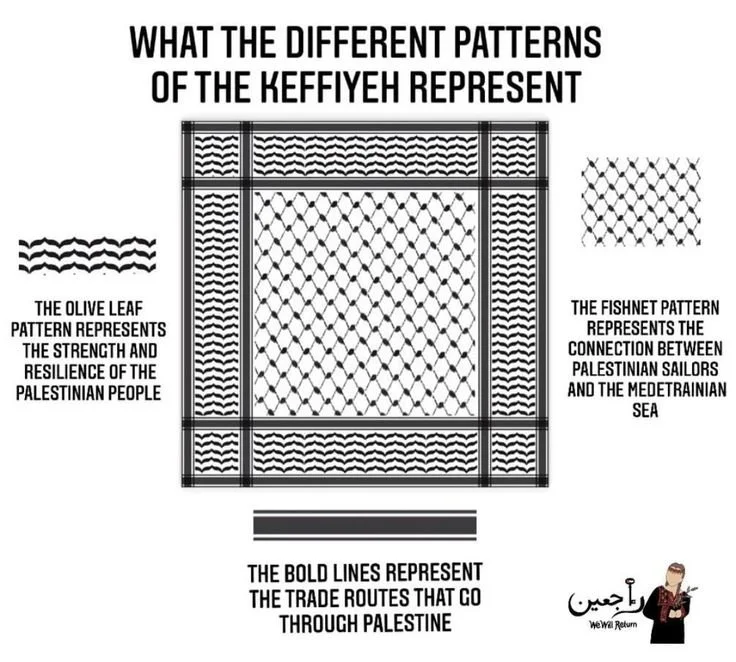The Palestinian keffiyeh: all you need to know about its orgins
In Palestinian culture, the keffiyeh is characterised by an intricately patterned black-and-white pattern. It originated among the Bedouins as a practical and protective covering for the head and face, especially in their arid desert climate. Since the 1936–1939 Arab revolt in Palestine, it has been a prominent symbol of Palestinian nationalism during the Israeli-Palestinian conflict.
Shorthand for struggle
The keffiyeh has a modern origin in Palestine among the fellah, rural workers, and Bedouins. As a way to protect themselves from the hot summer sun and the cold winter, both groups wore the garment over their heads over their necks.
Traditionally, covering one's head was an important principle in Palestinian culture, according to Lingala.
"The keffiyeh afforded breathability through air pockets created by folds in the fabric," she says.
More educated, urban Palestinians, or effendi, wore fez hats or tarboushes, a deep-red felt hat popularized by the Ottomans and adopted by the locals as their standard form of dress.
Fashion and Politics, written by cultural historian Jane Tynan, explores the scarf's significance. She says: "The Ottoman Empire's dress codes had the effect of erasing ethno-religious identities, but would have been worn as a norm by urban dwellers."
As a result of the Turkish empire losing its Near Eastern territories during World War I and the Arab Revolt in 1936, Palestinian nationalists began using the keffiyeh to conceal their identities and avoid arrest, resulting in a call by the British to ban the headscarves, which did not succeed. It was a "pivotal moment in Palestinian culture" when Palestinians adopted the fabric as a symbol of solidarity. After the Nakba and the establishment of Israel, the symbol remained a staple of Palestinian national identity.
Yasser Arafat, the late Palestinian leader, popularized the garment decades later in the 1960s. Saca writes: "Abu Ammar [Arafat] would never appear at an event without it."
He always placed his keffiyeh on his head, placing the longer edge over his left shoulder. Some have said it resembled a map of Palestine before 1948.
As the Palestinian flag was banned by Israeli occupation authorities from 1967 until 1993, the scarf took on a powerful symbolism, according to Ted Swedenburg, an anthropology professor at Arkansas University.
"Portable and visible symbols" were important to Palestinians, Swedenburg says, adding that with the flag banned by the occupation for almost 30 years, the keffiyeh, "to which so much rich symbolism and history was attached, served as an everyday, portable, visual expression of Palestinian identity".
Wheat, olives and honey
There are a number of symbolic meanings associated with the black stitching on a white cotton keffiyeh, some of which have been verified, but there are no shortage of interpretations among Palestinians.
"A fishing net, a honeycomb, the joining of hands, or the marks of dirt and sweat wiped off a worker's face" are some of the descriptions given. Others suggest that the design represents ears of wheat, a reference to Jericho, one of the first cities to cultivate wheat.
"Barbed wire" is another pattern that Palestinian artist Fargo Tbakhi adds to the list, explaining it can represent "that ever-present symbol of occupation," though his preference is for the fishing net design, also called "fatha" (opening).
"[I see it] as a symbol of our identity, a model for being Palestinian, it articulates one possible futurity for our people," he writes in the Los Angeles Review of Books.
"A fishnet is an image of collectivism, of entanglement and dependence: in a net, singular strands become something larger, stronger. As one strand, I am always yearning to be knotted together with others, so that we are better able to hold, to catch."
According to Palestinian author Susan Abulhawa, the keffiyeh's patterns "tell stories of Palestinian life, as do the patterns of tatreez [Palestinian embroidery], which are a language unto themselves, telling stories of location, lineage, occasion, and historical significance."
Black stitching is sometimes referred to as a honeycomb design, honoring the region's beekeepers; some Syrians (where the cloth is also worn) believe it symbolizes the joining of hands and the rubbing away of dirt and sweat by workers.
One tweet depicted Palestine's olive trees as showing "strength and resilience" as another interpretation of the design:
Abulhawa agrees: "The 'bird-like' motifs along the border are interconnected olive leaves, referring to the significance of the olive tree in Palestinian life."
In Palestinian culinary, social, and economic life, olives - in all their forms - played an important role, says Abulhawa. "Olive trees provided not just a means of sustenance and income, but the care of trees and harvest season provided for important social and national events in our society. Olives are present in our poetry, songs, tatreez, food, folklore, and familial lore. Finally, the geometric long borders in the keffiyeh denote the trade routes that both imported and exported products to and from Palestine."
Not always Black and White
As a traditional Arab garment made of wool, the keffiyeh - also known as the shemagh in Jordan and Syria, and as the ghutra in Gulf countries - remains distinctly Arab despite being non-religious, since it is worn by Arab Christians, Muslims, Druze and secular citizens across the region, in different colors and designs.
Unlike the Palestinian and Syrian scarf, which is black and white, other scarves have patterns.
